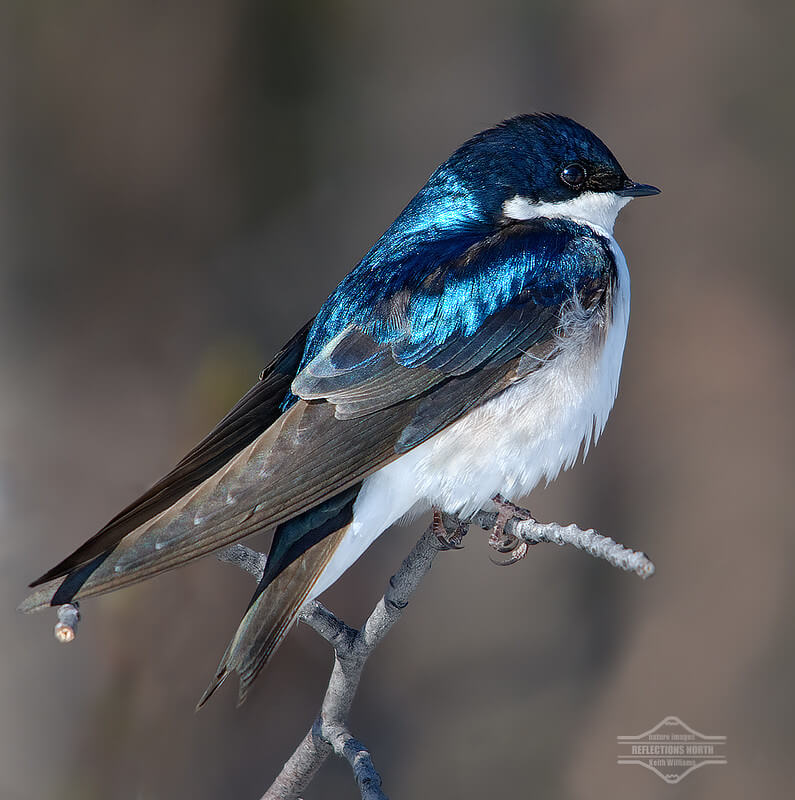Birds of an (Iridescent) Feather Flock Together
By Elizabeth Domenech
Broadcast 5.18 & 5.21.2022

Feathers’ iridescence depends on refracting light, sometimes gleaming more vibrantly, as in this photo of a tree swallow. Photo by Keith Williams, CC BY-NC-ND 2.0.
Listen:
What do tree swallows, starlings, pigeons, hummingbirds, and mallard ducks all have in common? Besides being birds, of course, each of these species sports iridescent feathers that glimmer and shine when the light hits them. While observing a pair of pesky starlings at my bird feeder one day, the gleam of their feathers caught my eye and caused me to wonder: Why do some birds have iridescent feathers while others do not? What causes iridescence, and how does it serve the birds who flaunt these feathers?
The color we observe in bird feathers is derived from the pigmentation of the feather, the structure of the feather itself, or a combination of the two. Pigmentation is “the natural coloring of animal or plant tissue.” Some birds acquire pigments called carotenoids through their diet, like flamingos who develop their pink coloring from eating shrimp. Other pigments called melanin are naturally occurring in the skin and feathers of birds (much like melanin in human skin and hair), producing a range of black, grey, brown, and orange colors.
Iridescence, by contrast, is a form of structural coloration. The word iridescence comes from the Latin and Greek iris, meaning rainbow. In iridescent feathers, a keratin protein in the feather functions as a prism, refracting shorter waves of light to showcase blues, violets, purples, and greens. Like kids learning to mix primary colors to produce secondary colors, sometimes the color we end up seeing on a bird feather is a combination of the color of the light and the underlying pigment: mixing blue light with underlying yellow carotenoids makes green feathers.
Because iridescence depends on refracting light, the intensity of the color can change with the viewing angle, a quality called directionality. This explains why the blue-green of tree swallows appears more vibrant from some angles than others, and why their glossy sheen seems to disappear on a cloudy day. Birds can take advantage of this directionality of light to visually communicate within their species, using the resulting iridescence to direct signals at mates or rivals. Hummingbirds, one of the few species whose females have iridescent feathers, will sometimes use their iridescence to defend food territories. Iridescence may also help with coordinating group movements in flocking species. Just like a school of fish uses iridescent stripes to orient and change direction, the directionality of iridescent feathers can highlight distances and placement of other birds in the flock, helping synchronize the behavior of the flock as a whole.
Birds will also use their iridescence in courtship displays, and it can play a role in selecting mates. In peacocks, the degree of iridescence in the striking eye spots on their tails has been shown to affect males’ reproductive success.
So why don’t all birds sport iridescent feathers? Perhaps because iridescence comes with a cost. Several studies show that iridescence is correlated with decreased hydrophobicity, meaning that water doesn’t repel off of iridescent feathers the way it does non-iridescent feathers. The same structure that allows light to refract increases the surface area, allowing more water to stick to the feather. Studies suggest this same quality also makes the feathers less efficient at self-cleaning than non-iridescent feathers, and therefore more susceptible to bacteria. As a result, birds with iridescent feathers must spend more time maintaining their plumage.
What began as an exploration of the quality of beautiful feathers led me to greater appreciation for all the ways birds have adapted to use iridescence to their advantage as they communicate with one another. The next time I see a murmuration of starlings, I’ll know they have their iridescence to thank for avoiding full-speed airborne collisions. And the next time I see a pigeon preen, I’ll know it’s not in vain.
Every week since 1991, Field Notes has inquired about Montana’s natural history. Field Notes are written by naturalists, students, and listeners about the puzzle-tree bark, eagle talons, woolly aphids, and giant puffballs of Western, Central and Southwestern Montana and aired weekly on Montana Public Radio.
Click here to read and listen to more Field Notes. Field Notes is available as a podcast! Subscribe on iTunes, Google Play, or wherever you listen to podcasts.
Interested in writing a Field Note? Contact Allison De Jong, Field Notes editor, at adejong [at] montananaturalist [dot] org or 406.327.0405.
Want to learn more about our programs as well as fun natural history facts and seasonal phenology? Sign up for our e-newsletter! You can also become a member and get discounts on our programs as well as free reciprocal admission to 300+ science centers in North America!












